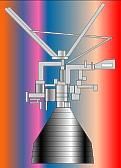
Home - Search - Browse - Alphabetic Index: 0- 1- 2- 3- 4- 5- 6- 7- 8- 9
A- B- C- D- E- F- G- H- I- J- K- L- M- N- O- P- Q- R- S- T- U- V- W- X- Y- Z
YF-77
 YF-50t New 50 tonne Lox/LH2 engine Credit: © Mark Wade |
AKA: YF-50. Status: Operational 2016. Date: 2016. Thrust: 700.00 kN (157,360 lbf). Unfuelled mass: 2,700 kg (5,900 lb). Specific impulse: 430 s. Specific impulse sea level: 310 s. Burn time: 520 s. Height: 4.20 m (13.70 ft).
Gimbaled in two axes, hydrogen bled from the engine was used to pressurize the oxygen tank, and helium was used to pressurize the hydrogen tank. Firing tests began in 2003. First launch in 2016. Thrust (sl): 510.000 kN (110,000 lbf). Oxidizer to Fuel Ratio: 5.45. Chamber pressure: 10.2 Mpa (1480 psi); Area ratio: 49.0.
Wikipedia Narrative:
In January 2002, the development of a new cryogenic engine was approved by the Commission for Science, Technology and Industry for National Defense. Development responsibility was assigned to the Beijing Aerospace Propulsion Institute, a division of the Academy of Aerospace Launch Propulsion Technology. The preliminary design was completed by mid-2002 and the first set of components was manufactured by early 2003. The same year saw the initial component and subsystem tests, with the gas generator successfully performing its first test on July 30. By December 2003 the whole powerpack successfully passed its first integrated test, and on September 17, 2004 a successful 50 seconds firing of a whole prototype engine was achieved.
In May 2013 the formal qualification testing campaign began. By the end of 2013 more than 70 tests and 24,000 seconds of firing at steady state conditions have been performed by 12 engines. The concept review confirmed that the performance goal and launcher requirements were met, and the engine was ready for integration for the maiden launch of the Long March 5 rocket.[2] Engine development began in the 2000s, with testing directed by the China National Space Administration (CNSA) commencing in 2005. The engine has been successfully tested by mid-2007.
Technical Description
The requirements for an inexpensive and high reliability disposable engine were met by using dual 510 kN (110,000 lbf) (sea level) gas generator engines on a single mounting frame. Each engine had dual turbopumps with separate gas exhaust. Both turbines were fed by a single fuel rich gas generator. The combustion chambers and throat were regeneratively cooled, while the welded pipe constructed nozzle used dump cooling. The turbopumps used a solid propellant cartridge for start up, while the gas generator and combustion chamber used pyrotechnic igniters. The valves and prevalves were helium actuated ball valves. The thrust and mixture ratio wete calibrated with venturis and a propellant utilization valve on ground tests. The engine also has dual heat exchanger to supply hot gaseous hydrogen and oxygen for tank pressurization.
All subsystems were attached to the combustion chamber and gimbal was achieved by rotating the whole engine on two orthogonal planes with two independent actuators. The injector plate used coaxial injectors with some extended to create baffles that prevent high frequency instabilities. The Titanium fuel turbopump used a two-stage pump with inducer and was actuated by a two-stage axial turbine. It rotated at 35,000 [rpm] and supplied a discharge pressure of 16.5 MPa (2,390 psi). The oxydizer turbopump used a single stage centrifugal pump with a helical inducer driven by a two-stage turbine. It rotated at 18,000 [rpm] and supplied a discharge pressure of 14 MPa (2,000 psi).
Country: China. Launch Vehicles: CZ-NGLV-540, CZ-NGLV-522, CZ-NGLV-522/HO, CZ-NGLV-504, CZ-NGLV-504/HO, CZ-NGLV-540/HO. Propellants: Lox/LH2. Stages: CZ-NGLV-500. Agency: CAALPT.
Back to top of page
Home - Search - Browse - Alphabetic Index: 0- 1- 2- 3- 4- 5- 6- 7- 8- 9
A- B- C- D- E- F- G- H- I- J- K- L- M- N- O- P- Q- R- S- T- U- V- W- X- Y- Z
© 1997-2019 Mark Wade - Contact
© / Conditions for Use